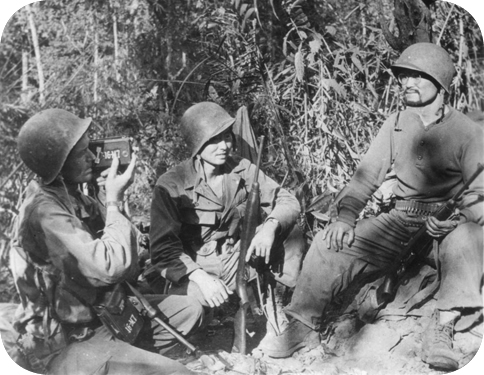Honor and Sacrifice: The Roy Matsumoto Story
Produced by Stourwater Films. 2013. 28 minutes. In English.
Study areas: Japan, World War II, U.S. internment camps

The idea of risking your life to prove your loyalty to a country that has imprisoned your friends and relatives only because they resembled enemies seems to be a far-fetched one, until one compares American history in 1942 to what has happened since September 11, 2001. In 1942, American citizens of Japanese ancestry were rounded up like cattle and whisked off to “relocation camps” for “their own protection,” mainly because they looked like the people who had bombed the American naval base at Pearl Harbor in Hawai’i.
Young boys born to Japanese-American parents (many of whom were themselves born in the United States) flocked to join the American military in part to prove their allegiance to a nation that had imprisoned them simply because of racial profiling. Thousands of these young men served bravely while their relatives languished in concentration camps in the middle of the American desert. Thousands of them were wounded or killed serving in such military units as the 442nd Regimental Combat Team, the single most highly-decorated American military unit during World War II. Many of these young war veterans returned to the United States as war heroes after having been wounded in combat, visited those concentration camps, separated from their parents by strands of barbed wire.
Honor and Sacrifice is a 28 minute documentary that tells the story of Roy Matsumoto, an American-born “kibei” (born abroad, educated in Japan) who served in the jungles of Burma as part of the fabled Merrill’s Marauders. Matsumoto volunteered for military service from a concentration camp outside Jerome Arkansas. While he was being honored for his bravery in several desperate battles, his family was ripped apart. One brother served in the American army; three brothers were drafted into the Japanese military (one of whom fought at Guadalcanal); his mother, father and two sisters were trapped in Hiroshima, escaping the American atomic bombing only by weeks. The story is recounted partially by his daughter, who discovered his heroism purely by chance and only after decades of official American government secrecy. Short video interviews of Matsumoto himself (now 100 years old) are interspersed with black-and-white period photographs, many taken by his father who was a professional photographer. One evocative photo from U.S. government archives, shows a tall white American officer towering over the diminutive, emaciated Matsumoto who is being honored for his bravery.
Honor and Sacrifice can be used to illustrate the shameful story of American WWII racism or to introduce the topic of continued racial profiling in a post-9/11 world. Students can be assigned short research topics such as Executive Order 9066, the 442nd Regimental Combat Team, Merrill’s Marauders, the “Relocation Camps,” or Ronald Reagan’s belated apology to Japanese Americans. They could also be invited to make comparisons of these events to what happened to loyal Americans of Arab ancestry (or to attacks on Sikhs and Muslims) in 21st century America.
Louis G. Perez is a Distinguished University Professor of History at Illinois State University. He is the author of several books on Japanese history including The History of Japan, 2nd Revised Edition, Westport, CT: Greenwood Press, 2009; a text written for secondary school students.
Last Updated: October 21, 2013

